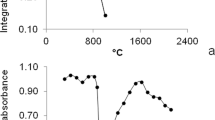Summary
Cadmium is enriched by an extraction with APDC/MIBK and subsequent reextraction with nitric acid. A procedure is described for analyzing these solutions directly by means of flameless atomic absorption, inspite of the high concentration of nitric acid in a zirconium coated graphite tube. These tubes, proved to be very resistant (150–300 analyses). After treatment of the tubes with a Fe3+-solution no interference by accompanying anions and cations could be observed. By the extraction and reextraction procedure described cadmium is enriched by a factor of five. Samples of higher cadmium concentrations were analyzed by means of flame atomic absorption after the same sample preparation. Working conditions for flameless and flame atomic absorption are given. Detection limits have been calculated as 0.53 μg Cd/l in the case of flameless, 19.4 μg Cd/l in the case of flame atomic absorption. These values are further decreased by the above enrichment procedure to 0.1 and 4 μg Cd/l, respectively.
Zusammenfassung
Es wird ein Verfahren beschrieben, das es gestattet, nach einer Anreicherung von Cadmium durch Extraktion mit APDC/MIBK und anschließender Reextraktion mit Salpetersäure, die stark salpetersaueren Reextrakte direkt in Zirkonium-beschichteten Graphitrohren bei Verwenden der flammenlosen Atomabsorption zu vermessen. Diese Rohre zeigten eine gute Lebensdauer (150–300 Analysen). Durch eine Behandlung der Rohre mit einer Fe3+-Lösung konnten Beeinflussungen der Cadmiumsignale durch Begleitstoffe verhindert werden. Cadmium wird bei der Extraktion und Reextraktion um den Faktor fünf angereichert. Bei hohen Cadmiumgehalten in den Proben kann die Analyse bei gleicher Probenvorbereitung mit Hilfe der Flammenatomabsorption durchgeführt werden. Die Arbeitsbedingungen für die flammenlose, sowie für die Flammen-Atomabsorption werden angegeben. Als Nachweisgrenzen bei Verwenden der flammenlosen Atomabsorption wurden im Mittel 0,53 μg Cd/l, für die Flammenatomabsorption 19,4μg Cd/l gefunden, die durch die Anreicherung auf ca. 0,1, bzw. 4 μg Cd/l gesenkt werden.
Similar content being viewed by others
Literatur
Aubert, H., Pinta, M.: Trace elements in soils. Amsterdam-Oxford-New York: Elsevier Publ. Co. 1977
Christian, G. D., Feldmann, F. J.: Atomic absorption spectroscopy. New York-London-Sydney-Toronto: Wiley-Intersci. 1970
Danielsson, L., Magnusson, B., Westerlund, S.: Anal. Chim. Acta98, 47 (1978)
Dudas, M. J.: Atomic Absorption Newsl.13, 109 (1974)
Flaschka, H. A., Barnard, A. J., Jr.: Chelates in analytical chemistry. New York: Marcel Dekker, Inc. 1972
Gomišček, Z., Lengar, J., Černetič, Hudnik, V.: Anal. Chim. Acta73, 97 (1974)
Hulanicki, A.: Talanta14, 1371 (1967)
Manning, D. C.: Atomic Absorption Newsl.15, 42 (1976)
Ortner, H. M., Kantuscher, E.: Talanta22, 581 (1975)
Pfeilsticker, K., Markard, C.: Z. Lebensmittel-Unters. Forsch.158, 129 (1975)
Scheffer, F., Schachtschabel, P.: Lehrbuch der Bodenkunde. Stuttgart: Ferdinand Enke 1976
Schmidt, W., Dietl, F., Sansoni, B.: GSF-Bericht, S. 371 (1975)
Schmidt, W., Dietl, F.: Fresenius Z. Anal. Chem.291, 213 (1978)
Sebastiani, E., Ohls, K., Riemer, G.: Fresenius Z. Anal. Chem.246, 105 (1973)
Slavin, W.: Atomic absorption spectroscopy. New York-London-Sydney: Intersci. Publ. 1968
Stiefel, Th., Schulze, K., Tölg, G.: Anal. Chim. Acta87, 67 (1976)
Syty, A.: CRC Crit. Rev. Anal. Chem.4, 155 (1974)
Volland, G., Kölblin, G., Tschöpel, P., Tölg, G.: Fresenius Z. Anal. Chem.284, 1 (1977)
Vries, M. P. C. de, Tiller, K. G., Beckwith, R. S.: Comm. Soil Sci. Plant Analysis6, 629 (1975)
Wels, B.: Atom-Absorptions-Spektroskopie. Weinheim/Bergstr.: Verlag Chemie 1972
Author information
Authors and Affiliations
Rights and permissions
About this article
Cite this article
Schmidt, W., Dietl, F. Bestimmung von Cadmium in Boden- und Sedimentaufschlüssen und -extrakten mit der flammenlosen Atomabsorption in Zirkonium-beschichteten Graphitrohren. Z. Anal. Chem. 295, 110–115 (1979). https://doi.org/10.1007/BF01171496
Received:
Issue Date:
DOI: https://doi.org/10.1007/BF01171496



